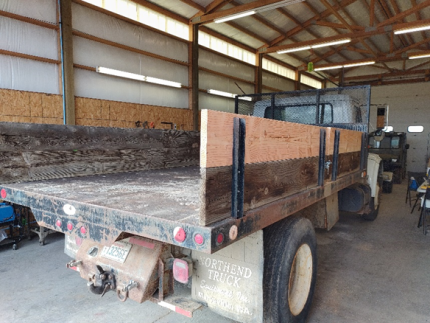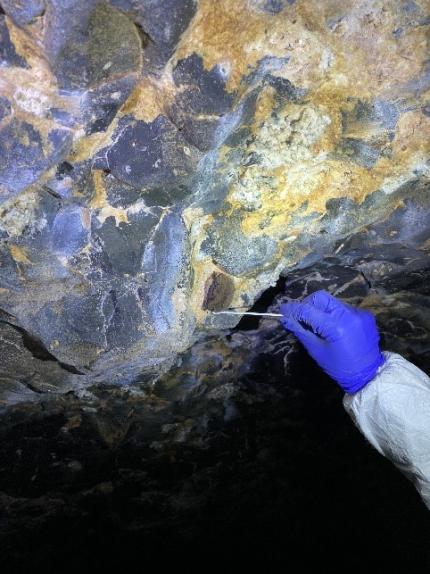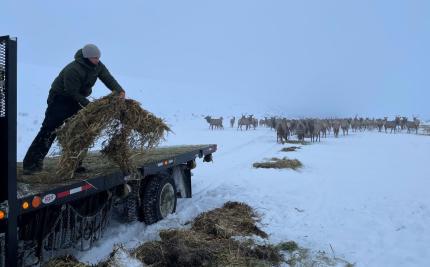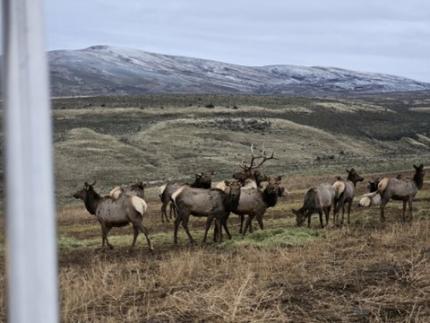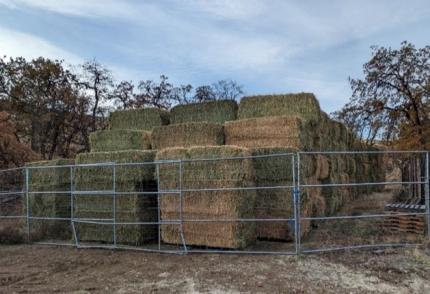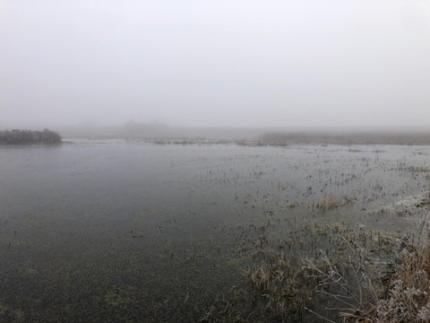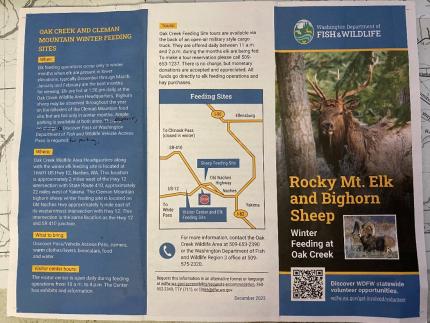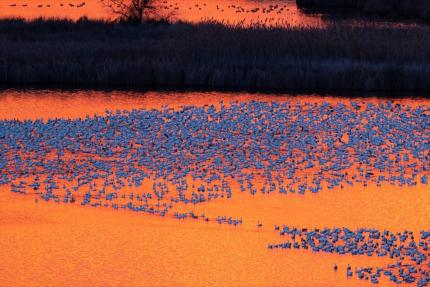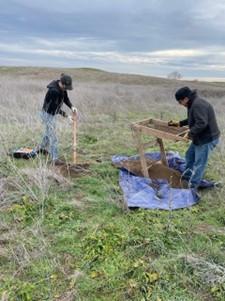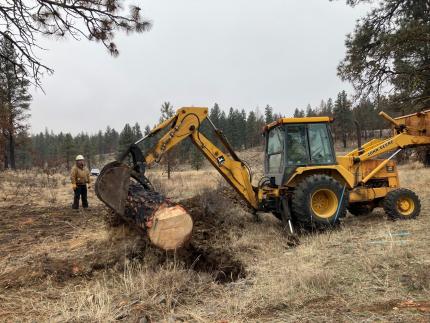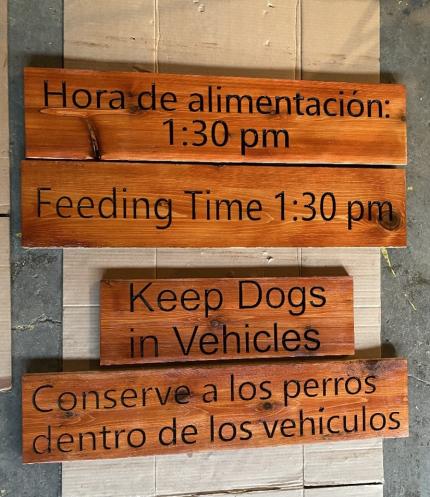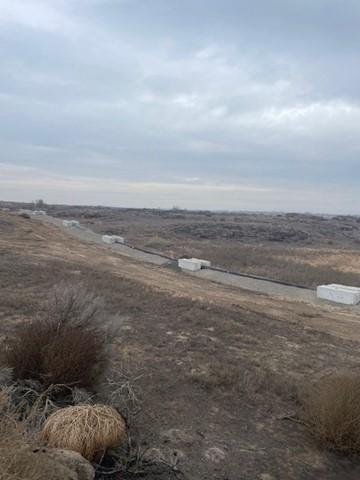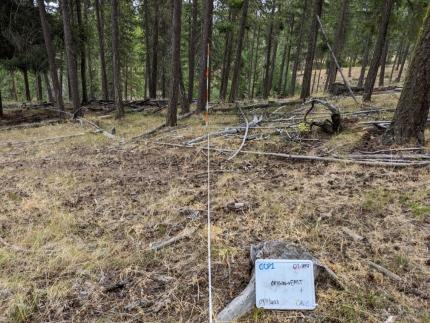Biweekly report Feb1-15 2024 - Region 3 (South Central)
Managing Wildlife Populations
Cougar Sealing: District 4 Wildlife Conflict Specialist Hand sealed a cougar for a hunter who harvested it in the Blue Mountains GMU 156.
Bobcat Sealing: District 8 Biologist Wampole sealed a bobcat harvested in Kittitas County.
Wolf Monitoring: District 8 Biologist Wampole set additional camera traps to monitor wolf activity in Kittitas County following the observations of tracks.

Rattlesnake Hills Elk Survey Completed: District 4 Wildlife Biologist Fidorra completed surveys for Hanford elk herd with the help of District 8 Biologists Wampole and Moore. Flight photographs of groups were taken and still need processed before herd numbers are updated.

Oak Creek Wildlife Area: The winter elk feeding program continues on the Oak Creek Unit and Cowiche Unit of the Oak Creek Wildlife Area. Elk are in seasonally good health and are monitored daily throughout the feed season. Winter weather has been mild through the beginning of February 2024. Elk are moving in and out of the feed site daily. Additionally, they are seen grazing away from the feed sites. However, Oak Creek staff members continue to feed approximately 2300 elk on the Cowiche Unit and 650 elk on the Oak Creek Unit daily.


Pelican Diet Study: District 4 Wildlife Biologist Fidorra joined Region 3 fisheries staff members and Olympia Diversity Program and Science Program staff members for discussions with the Yakama biologists regarding a diet study on white pelicans and interactions with salmon smolt and predatory fish.
Audubon Climate Watch Point Counts: District 4 Wildlife Biologist Fidorra assisted a local Audubon chapter on a morning of long-term point counts in Benton County. The work was part of the National Climate Watch project that tracks changes in bird species distribution related to climate change.
Eagle Carcass Testing and Avian Influenza: District 4 Wildlife Biologist Fidorra assisted with responding to three separate eagle mortalities in the Tri-city area. Avian influenza (AI) testing was conducted on two of the three birds with one positive and one negative result. AI has been an ongoing concern for wildlife in the area over the past two years.
L.T. Murray Darting Training: Wildlife Veterinarian Mansfield put on a large ungulate darting training at the L.T. Murray’s Joe Watt feed site. Several elk were darted, and samples were taken.


Providing Recreation Opportunities
Wenas Wildlife Area All Trails Public Lands Program: Wenas Wildlife Area Lands and Recreation Specialist Frame are now working with All Trails via their Public Lands Program to help manage the recreational trails throughout the Wenas Wildlife Area.
This program was created by All Trails to work with land managers (federal, state, city, and private). With this program, the Wenas Wildlife Area will be able to give critical information regarding trails in the area such as, trail closures, emergency restrictions, seasonal closures, accurate trail descriptions, etc. The program will also help with data collection such as trail use and popularity.
Sheep Company Road Target Shooting Area Clean-Up: Wenas Wildlife Area Lands and Recreation Specialist Frame collected 510 pounds of trash and target shooting material. Most of the items were targets used incorrectly by the public. Items include wood pallets, cardboard, metal, brake rotors, and paper. Frame also removed a deceased and partially butchered domestic pig and three buckets of paint primer from the horse parking area on Sheep Company Road.


Kiosk and Parking Area Development: Wenas Wildlife Area Technician Janes and Assistant Manager Taylor laid out barrier rock just past the lower Buffalo Road gate and installed a kiosk this winter. This is a second parking area lined out for the road. Increased signage is needed because it is a popular area used for hiking. Wenas Wildlife Area Manager Gray coordinated with the Department of Natural Resources on the kiosk installation and barrier rock placement.

Providing Conflict Prevention and Education
Rattlesnake Hills Elk: District 4 Wildlife Conflict Specialist Hand monitored for elk activity on the Hanford National Monument and adjoining private lands. Large numbers of elk continue to occupy low elevation areas near Highway 240 on the Hanford Monument.
Deer Damage and Youth Damage Hunt Opportunities: District 4 Wildlife Conflict Specialist Hand deployed youth from the Region 3 special permit roster to Kahlotus area landowners experiencing deer damage in their wheat fields. Hand continued coordination on hazing, permit issuance, and reporting. Additionally, a landowner along the Yakima River has requested youth hunters for hazing and removal efforts.
Possible Cougar Observation in Finley: District 4 Wildlife Conflict Specialist Hand assisted a local Washington Department of Fish and Wildlife Enforcement officer with a call concerning a cougar observed near Finley. The area was canvassed for signs or evidence of cougars, but nothing was located. They provided the homeowner with information concerning cougar behavior and asked the homeowner to let them know if it returns.
Dumped Elk Carcass: District 4 Wildlife Conflict Specialist Hand assisted local Washington Department of Fish and Wildlife Enforcement staff members with the investigation of elk parts and garbage that were dumped near Horn Rapids Dam.
Kittitas County Conflict: Conflict Technician Leuck and Conflict Specialist Wetzel hazed some elk from areas in Kittitas County. Elk ventured into areas in Thorp, Vantage, Kittitas, Badger Pocket, and Cle Elum. They were mostly visiting haystacks and domestic animal feeding areas. Elk have been hazed away from I-90 in some locations.
Wetzel also worked with a nuisance wildlife control operator on a skunk issue in the city limits of Roslyn.
Yakima County Conflict: Conflict Technician Leuck and Conflict Specialist Wetzel repaired elk fence in the Cowiche area where elk were in orchards outside the elk fence. Elk were hazed from Tampico and the Tieton areas as well.


Presentation to Wildlife Area Volunteers: District 8 Biologist Wampole presented to Oak Creek Wildlife Area visitor center volunteers on the status of Yakima elk and management challenges. In addition, Wampole showcased information on the on-going test and remove bighorn sheep study being carried out in the Selah Butte/Umtanum and Cleman Mountain herds.
Conserving Natural Landscapes
Sunnyside Cleanup: Sunnyside-Snake River Wildlife Area Assistant Manager Ferguson and Natural Resource Technician Cardenas cleaned up dumped mattresses and other trash and installed a new cable gate at a road pull-off that was being targeted for loitering and garbage dumping recently. Hopefully the new gate will prevent further illicit activities.


L.T. Murray Parke Creek Culvert: L.T. Murray Wildlife Area Natural Resource Technician Blore and Manager Morrison worked with regional Habitat Program staff members to access a small culvert in Parke Creek that has failed in two spots.

Providing Education and Outreach
Oak Creek Wildlife Area Visitor Center: The Oak Creek Visitor Center continues to open daily from 10 a.m. to 4 p.m. with feed site tours available from 11 a.m. to 3 p.m. daily. The visitor center is completely staffed and operated by a group of volunteers, The Friends of Oak Creek Wildlife Area. As of the first week of February, they had conducted 210 tours and had approximately 4097 people visit the center.

L.T. Murray Outreach: L.T. Murray Wildlife Area Natural Resource Scientist Nass and Manager Morrison held two outreach events at the Joe Watt feed site for Thorp Elementary School students and home school students. Both groups played games for ecological education followed by group discussions.

Conducting Business Operations and Policy
Safety Stand-Up meetings: District 4 Wildlife Biologist Fidorra met with the Region 3 Wildlife Program supervisors as well as the Pasco Wildlife Program team to discuss safety and personal protective equipment. Several items were purchased to improve safety including personal floatation devices and supplies for vehicles.
District 8 Wildlife Capture Training: District 8 staff members, Wampole, Moore, and Wetzel participated in capture training of elk at the Watt and Robinson feed sites. Training was led by senior biology staff members and Wildlife Veterinarian Mansfield on safe capture operations to protect wildlife and human health and ensure data quality.
Other
New Staff Hired: District 4 finally has their first assistant district wildlife biologist! Biologist Hoffman started on Friday, Feb. 16 and will be helping to build capacity on Diversity Program projects for species including burrowing owls, ferruginous hawks, ground-squirrels, and other shrub steppe species. Blake attended the University of Montana for his BS in Wildlife and has nearly completed his master’s degree from Northern Arizona University on ringtail management at Grand Canyon National Park. Prior to this work for the National Park Service, he held various positions contributing to wildlife research in Idaho, Montana, and Colorado. His diverse background includes work with small and large mammal trapping, survey design, songbirds, bat mist-netting, chemical immobilization and veterinary experience. Having grown up enjoying the Washington outdoors in Chelan County, Hoffman is happy to be moving back to his home state with his wife. Please help WDFW in welcoming Biologist Hoffman as he settles into this new position based in the Pasco District 4 office.
Sunnyside-Snake River Wildlife Area Truck Maintenance: Sunnyside-Snake River Wildlife Area Assistant Manager Ferguson and Natural Resource Technician Cardenas installed new wooden side boards on wildlife area dump-bed truck International 4700, replacing broken boards. The truck is used for hauling gravel and other materials around the wildlife area for various projects.
